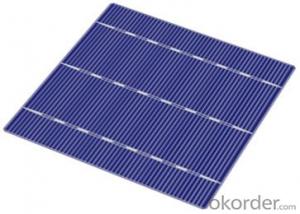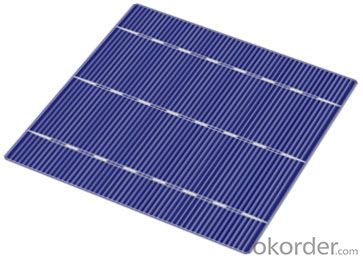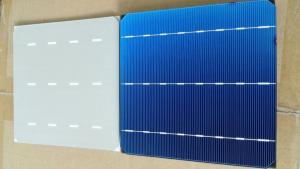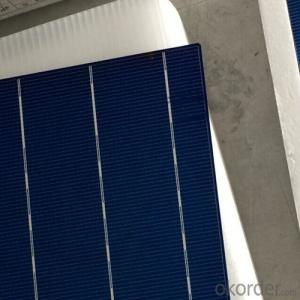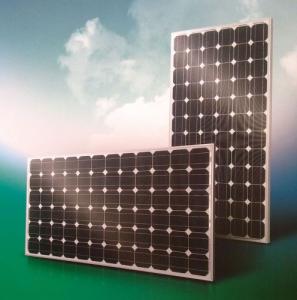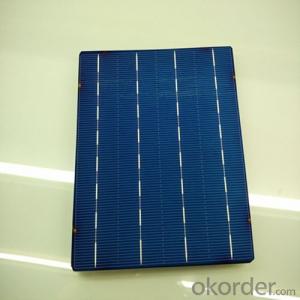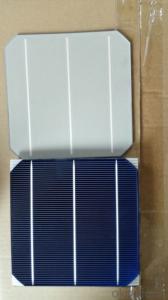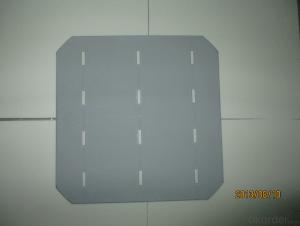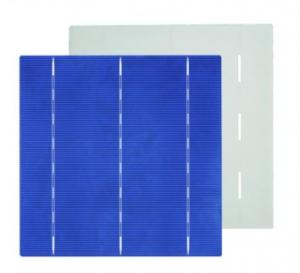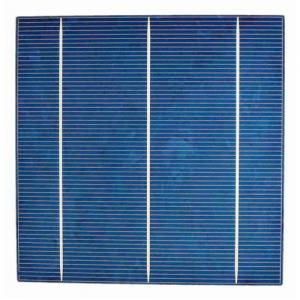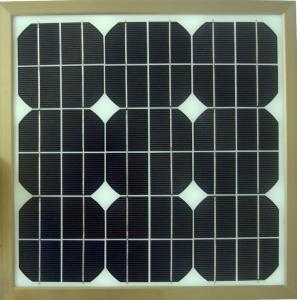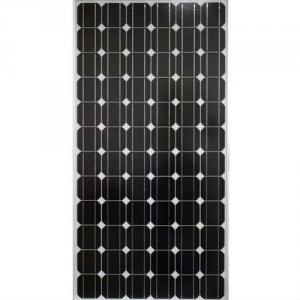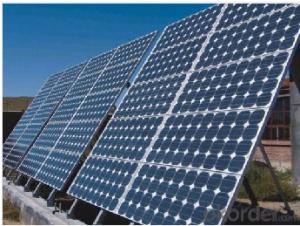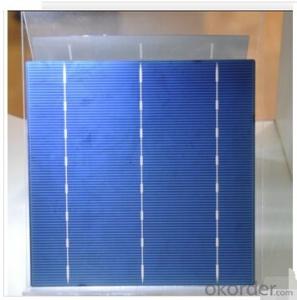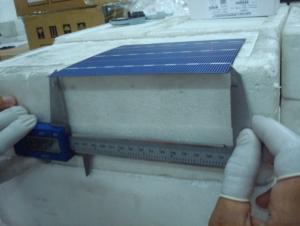Maxeon Solar Cells Poly 156x156mm with High Conversion Efficiencies
- Loading Port:
- Tianjin
- Payment Terms:
- TT or LC
- Min Order Qty:
- 10 watt
- Supply Capability:
- 10000 watt/month
OKorder Service Pledge
OKorder Financial Service
You Might Also Like
our cells special features:
1. High conversion efficiencies resulting in superior power output performance
2.Outstanding power output even in low light or high temperature conditions
3.Optimized design for ease of soldering and lamination
4.Long-term stability,reliability and performance
5.For 156P poly cells with high efficiency in photovoltaic conversion 16.3%-17.5%.
6.Low inverse current, high shunt resistance and high dependability.
7. Our poly cells efficiency include: 17%-18%.

Conversion of different solar materials
Solar photovoltaic power generation more important seats in the world's energy consumption in the near future, not only to replace part of conventional energy, are more likely to become the main body of the world's energy supply.
Solar cell is a light energy into electrical energy components. Low-cost high-efficiency solar cell photovoltaic technology long chase the target, it is hard to compete for each enterprise technology territory.
Solar cells market applications more wide-ranging and diversified to meet the various needs of photovoltaic products are constantly available, in addition to large-scale grid-connected PV power plant outside, combined with the construction of photovoltaic systems, small-scale PV systems, off-grid PV systems, also fast rise. The cost of solar cells and photovoltaic systems continued to decline and approximate cost of conventional power generation, is still the subject of photovoltaic industry development, and solar cells will continue to walk in high-efficiency, low-cost way.
We are familiar with crystalline silicon cells into single crystal and polycrystalline, except that the silicon wafers. Monocrystalline wafers made of polysilicon raw material crystal pullers pull into a bar and then sliced into monocrystalline, polycrystalline silicon film is made of polysilicon through ingot casting furnaces made of polysilicon ingots and then sliced. However, polycrystalline silicon photovoltaic cells still dominant the market currently.
The basic structure of a solar cell is to use a P-type and N-type semiconductors are joined together. The most important parameter is the photoelectric conversion efficiency. In the single-crystal battery, the current level of industrialization of developed N-type monocrystalline cells in about 21% -24%, the level of domestic industry P-type monocrystalline cells is about 18.7% -19.2%, 19.2% in overseas -20% or so. Polycrystalline battery’s industrialization level is the 17% - 17.5%. Here are edited from the N-type monocrystalline cells, P-type monocrystalline cells, polycrystalline cells are three types of contrast, certified technological frontier representatives listed below.
- Q: What is the role of solar cells in powering remote monitoring systems?
- Solar cells play a crucial role in powering remote monitoring systems as they provide a sustainable and renewable source of energy. By converting sunlight into electricity, solar cells eliminate the need for traditional power sources or frequent battery replacements in remote locations. This ensures continuous operation of monitoring systems, allowing data collection, transmission, and analysis to occur even in areas with limited access to the electrical grid. Solar cells enable reliable and environmentally friendly power supply, making them an essential component for remote monitoring systems.
- Q: Can solar cells be used for powering electric water heaters?
- Yes, solar cells can be used to power electric water heaters. By converting sunlight into electricity, solar cells can provide a sustainable and renewable source of energy to heat water in electric water heaters. This helps reduce reliance on traditional grid electricity and lowers carbon emissions.
- Q: What is the role of solar cells in powering data centers?
- Solar cells play a crucial role in powering data centers by harnessing the sun's energy and converting it into electricity. These cells, also known as photovoltaic cells, generate clean and renewable energy that can be used to fulfill a significant portion of a data center's power requirements. By utilizing solar power, data centers can reduce their reliance on traditional fossil fuel-based energy sources, minimize their carbon footprint, and contribute to a more sustainable and environmentally friendly approach to powering their operations.
- Q: Can solar cells be used in harsh climates?
- Yes, solar cells can be used in harsh climates. Solar cells are designed to withstand a wide range of environmental conditions, including extreme temperatures, high humidity, and strong winds. Additionally, advancements in solar technology have made solar panels more durable and resistant to damage from factors like snow, hail, and dust. However, it is important to consider the specific climate conditions and take necessary precautions to ensure the optimal functioning and longevity of solar cells in harsh climates.
- Q: How are solar cells used in calculators?
- Solar cells are used in calculators to convert sunlight into electricity. This electricity is then used to power the calculator, eliminating the need for batteries or other external power sources.
- Q: What is the role of solar cells in powering electric vehicles?
- Solar cells play a crucial role in powering electric vehicles by converting sunlight into electricity. These cells are typically mounted on the roof or body of the vehicle, absorbing sunlight and generating electrical energy. This energy is then used to charge the electric vehicle's battery, providing an additional source of power and extending its range. Although solar cells alone may not be sufficient to fully power an electric vehicle, they help reduce reliance on traditional charging methods and promote sustainable and renewable energy usage.
- Q: Can solar cells be used to power cars?
- Yes, solar cells can be used to power cars. Solar-powered cars utilize photovoltaic cells to convert sunlight into electricity, which can then be used to power the vehicle's electric motor. While solar-powered cars are still in development and face challenges such as limited energy storage and efficiency, they hold potential for reducing reliance on fossil fuels and minimizing greenhouse gas emissions.
- Q: Can solar cells be used in powering e-bikes?
- Yes, solar cells can be used to power e-bikes. Solar panels can be mounted on the bike's frame or incorporated into accessories like panniers or baskets. These panels convert sunlight into electricity, which charges the bike's battery, providing a renewable and sustainable source of power.
- Q: What is the impact of bird droppings or debris on solar cell performance?
- Bird droppings or debris on solar cell surfaces can significantly impact their performance. The accumulation of bird droppings or debris on the surface of solar cells can block sunlight from reaching the cell, reducing the amount of energy the cell can generate. This obstruction can lead to a decrease in the overall efficiency of the solar panel. Additionally, bird droppings contain corrosive substances that can damage the protective coatings on the solar cells, potentially reducing their lifespan. Therefore, regular cleaning and maintenance of solar panels is essential to ensure optimal performance and maximize energy production.
- Q: Are solar cells affected by shade?
- Yes, solar cells are affected by shade. When solar cells are partially shaded, it reduces their efficiency and overall power output. Shading can create hotspots on the shaded cells, causing them to generate less electricity and potentially damage the cells. Therefore, it is important to ensure that solar panels are installed in areas with minimal shade to maximize their performance.
Send your message to us
Maxeon Solar Cells Poly 156x156mm with High Conversion Efficiencies
- Loading Port:
- Tianjin
- Payment Terms:
- TT or LC
- Min Order Qty:
- 10 watt
- Supply Capability:
- 10000 watt/month
OKorder Service Pledge
OKorder Financial Service
Similar products
Hot products
Hot Searches
Related keywords
